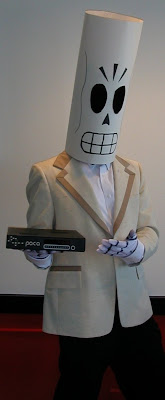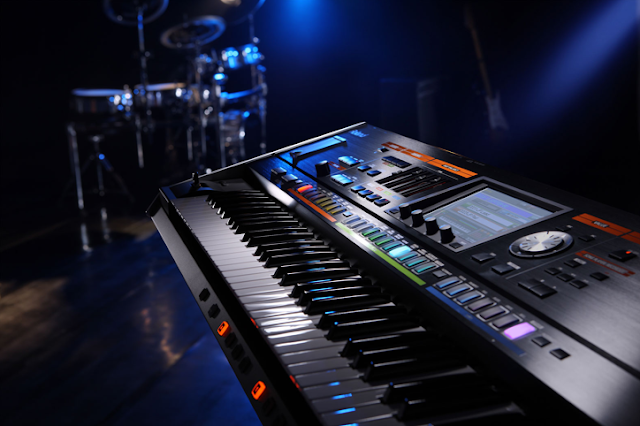 The Symbolic Sound Pacarana is here.
The Symbolic Sound Pacarana is here."Most powerful sound design workstation on the planet
That’s what Electronic Musician magazine calls the Kyma sound design environment. Future Music calls it the Holy Grail of sound design. Kyma's strength arises from its unique set of algorithms, the ease with which you can create endless combinations of those algorithms, and the unprecedented degree of real-time responsive control over the sound parameters.
You’ve already heard the sounds of Kyma in films like WALL•E, The Dark Knight, Master and Commander, Finding Nemo. And you've heard the interactive musical sounds of Kyma both on albums and in live sets by legendary musicians and producers like John Paul Jones, A.R. Rahman, Rich Costey, BT, and many others.
In 1990, Symbolic Sound revolutionized the sound design and music software industry with the introduction of Kyma, a graphical modular software sound design environment accelerated by the software-reconfigurable Capybara multi-processor sound computation engine. Symbolic Sound is committed to bringing the most advanced and flexible sound design technology to sound designers, musicians, educators, researchers, and creative professionals through its innovative hardware and software offerings.
A supercomputer designed for sound"
The flagship model Pacarana is 150% the power of a fully-loaded Capybara-320 for less than half the price. The entry-level Paca costs less than a Basic Capybara-320, but the new entry-level model is 5 times more powerful.
Falling in love with Kyma
What is it that people love about Kyma? For some people it’s having an unbounded environment for creating sounds that have never been heard before. Others cite outstanding technical support and the super-stability and reliability of the Kyma software during live performances. Still others rave about the continuous stream of free software updates full of new features and synthesis/processing algorithms. And everyone loves the legendary Kyma sound.
 What’s the secret behind the ‘Kyma sound’? The secret is in the software. When you have a supercomputer dedicated entirely to capturing, processing, and synthesizing sound, you have the luxury of being able to do things right. We don’t cut corners, and you can hear the difference."
What’s the secret behind the ‘Kyma sound’? The secret is in the software. When you have a supercomputer dedicated entirely to capturing, processing, and synthesizing sound, you have the luxury of being able to do things right. We don’t cut corners, and you can hear the difference.""On the back of the Pacarana—all the high-speed connectivity you want and need for digital audio production: two FireWire 800 ports, 2 USB ports, 100-base T Ethernet jack, and more…
A DC power plug connects the Pacarana to an external power supply that auto-senses voltage and frequency of the AC power source no matter where in the world you travel.
The Pacarana communicates with the Kyma X software running under Mac OS or Windows via FireWire 800 (IEEE1394B) or an 800-to-400 adapter cable.
Audio and MIDI input and output is handled via an external FireWire or USB converter or, for current Kyma owners, through a Capybara-320 with Flame FireWire I/O. Connect additional USB MIDI controllers like keyboards or fader boxes via the second USB port."
The above is just an excerpt. You can find more on the Symbolic Sound Pacarana website.
Update: the official press release came in at 4:33 PM:
"New Supercomputer for Sound:
Pacarana for Kyma Sound Design Environment
Champaign IL, January 12, 2009:
Musicians and sound designers for film, games and live electronic music now have a new supercomputer designed specifically for interactive sound exploration and live performance. The Pacarana and Paca are two new multiprocessor computers optimized for capturing, processing and synthesizing sound for the award-winning Kyma Sound Design Environment. Designed by Symbolic Sound Corporation to serve as a smaller, more affordable and more powerful replacement for the Capybara*320 sound computation engine, the new entry-level system is 5 times more powerful and costs $500 less than the older entry-level configuration. The power of the higher-end model exceeds that of a fully-loaded Capybara*320 but costs far less than half as much.
http://ssc-media.com/Pictures/Pacarana/Front%20(full%20res).JPG
http://ssc-media.com/Pictures/Pacarana/Nick%20Paca%20trimmed.jpg
Kyma, the Paca(rana), and backwards compatibility
Favored by sound designers for its unique set of algorithms, the ease with which one can create endless combinations of sound processing and synthesis algorithms, its reliability during live performances, and the responsiveness of real-time control over sound parameters, the Kyma sound design environment benefits from the new Paca(rana) platforms in the form of more polyphony, denser textures, faster loading times, more memory for live sampling and playback, enhanced portability, refinements in sound quality and the potential for future developments.
According to composer/performer and early adopter Phil Curtis of SoNu (http://www.sonusound.com):
I'm loving the new Pacarana. [M]ost of my old sounds just barely register on the meter, even sounds that just barely worked on the Capybara....I can already see that this is going to be a big leap in what I can do and paves the way for years of further development.
Sound designers who have been using Kyma X on the Capybara*320 can open and continue working on their current projects using the new hardware. Switching back and forth between the Capybara and the new hardware is completely transparent, and Symbolic Sound will continue to support Kyma X on the Capybara-320. Kyma users also have the option of keeping their Capybara*320 computer running alongside a new Pacarana, augmenting, rather than replacing, their current hardware.
Smaller, lighter, easily portable
With more sound designers going freelance, more musicians going on tour, and the airlines charging for each checked bag, Symbolic Sound decided to make the Pacarana and Paca small and light enough to fit into a backpack, laptop case or in a small rolling rack. The Pacarana footprint is the same as that of a MacBook Pro 15" (the Paca is about 3 inches shorter) and is 1 rack unit in height: ideal for live performances, working on the road, transporting from home studio to sound stage or from work to home.
Connectivity
On the back of the Paca(rana) are 2 USB ports, 2 FireWire 800 ports, and a DC power plug that connects to an external power supply brick (about the same size as the Mac Mini's power brick).
http://www.ssc-media.com/Pictures/Pacarana/Back%20(full%20res).JPG
The Paca and Pacarana communicate with the Kyma X software running under Mac OS or Windows via FireWire 800 (IEEE 1394B) or FireWire 400 (IEEE 1394A) using an 800-to-400 adapter cable.
Audio and MIDI input and output is handled by an external FireWire or USB converter or, for current Kyma owners, through a Capybara-320 with Flame FireWire I/O.
Additional USB MIDI controllers like keyboards or fader boxes can be connected via the second USB port.
More Audio and MIDI Input/Output options
Symbolic Sound decided to decouple the sound conversion from the sound computation functions in order to give customers more options for customizing their studio and mobile setups. Customers can now select from among a full range of high-quality third-party 1394TA AMDTP-standard FireWire and class-compliant USB audio converter devices available in nearly every size and price range. The growing list of qualified third-party converters includes the TC Electronic Konnekt series, the MOTU UltraLite-mk3, the Apogee Duet, and, on the USB side, the M-Audio Fast Track Pro and Logitech and Sennheiser USB headsets.
The Kyma Sound
Early reports from alpha and beta testers confirm that the sound quality of the Pacarana matches and, in some cases, surpasses that of its predecessor.
"People tell me that Kyma has an excellent word-of-mouth reputation for audio quality, and they usually attribute the quality to the Capybara*320 converters," says company president Carla Scaletti. "While it's true that the Capybara converters are excellent, the real secret to high-quality audio is in the algorithms. When you have a computer entirely dedicated to computing sound, you don't have to cut corners; we don't have to share our sound computer with a CPU-hungry operating system or a graphics subsystem; all Paca and Pacarana cycles are dedicated to computing high quality sound."
Live Control
You can use any USB or FireWire MIDI device or software for controlling sound parameters on the Paca(rana). Symbolic Sound has been working closely with Haken Audio (http://www.hakenaudio.com) to create seamless plug-and-play operation with the new MIDI-based Continuum fingerboard. Additional controllers with a high degree of Kyma integration include the Wacom tablet, the MotorMix, and the controllers supported by Camille Troillard's OSCulator (http://www.osculator.net) software, including the Nintendo Wiimote, the Jazz Mutant Lemur, the Logitech Space Navigator, and others.
Backpacking
The Paca(rana) fits perfectly into the hard-shell laptop sleeves made by Tom Bihn (http://www.tombihn.com) and Symbolic Sound is making the Tom Bihn Brain Cell sleeve and Brain Bag backpack available with the purchase of a Paca or Pacarana for hands-free transport of your laptop, Pacarana and other mobile audio gear.
Price and availability
Symbolic Sound is now shipping both the Paca and the Pacarana. The entry-level Paca is available for US $2970 and the professional studio model Pacarana is available for US $4402. To place an order, please visit http://www.symbolicsound.com or send email to info-kyma@symbolicsound.com
Summary
A lower entry-level price, a smaller footprint, and a whole lot of extra horsepower make Kyma X + Paca(rana) a supercomputer for sound designers and musicians!
Background
Symbolic Sound first revolutionized the sound design and music software industry in 1990 with the introduction of Kyma, a graphical modular software sound design environment accelerated by the software-reconfigurable Capybara multi-processor sound computation engine. The Paca(rana) is the fifth in a series of increasingly powerful sound computation engines designed and produced by Symbolic Sound to work in conjunction with the Kyma sound design environment (now in its sixth major release, not counting the hundreds of free updates between each major release). Symbolic Sound is committed to bringing the most advanced and flexible sound design technology to sound designers, musicians, educators, researchers, game developers, and other creative professionals through its innovative hardware and software offerings.
Symbolic Sound, the Symbolic Sound logo, Kyma, Pacarana, Paca, and Capybara and their logos are trademarks of Symbolic Sound Corporation. Other company and product names may be trademarks of their respective owners."












































































